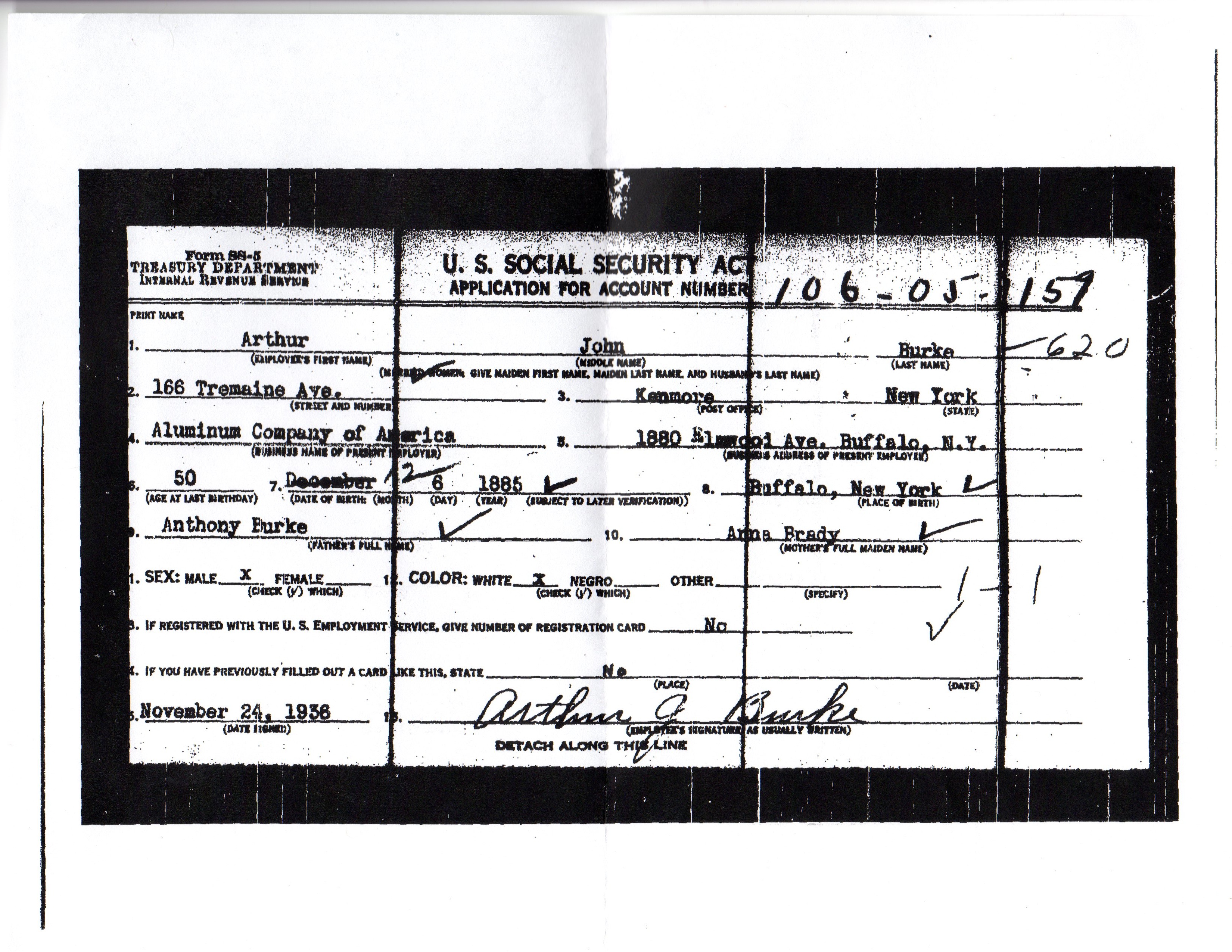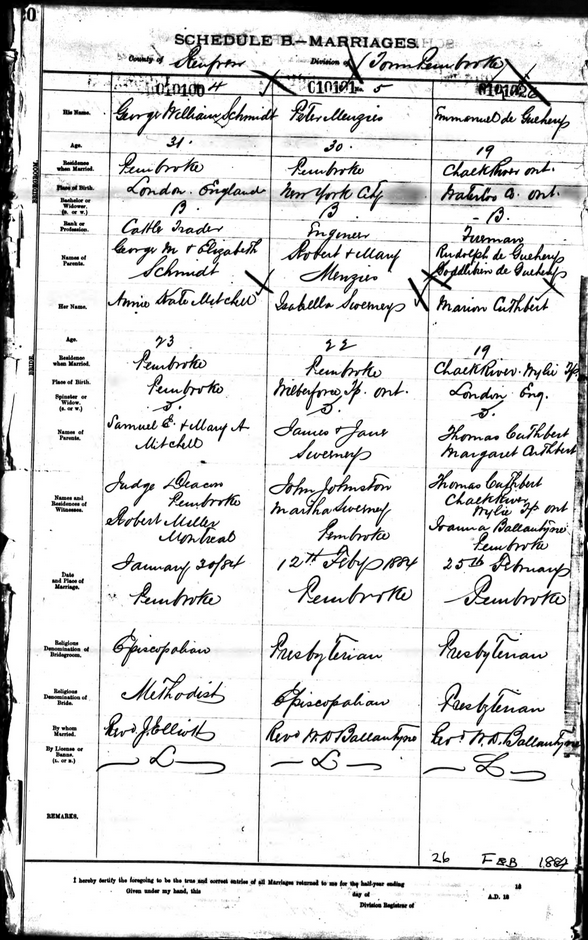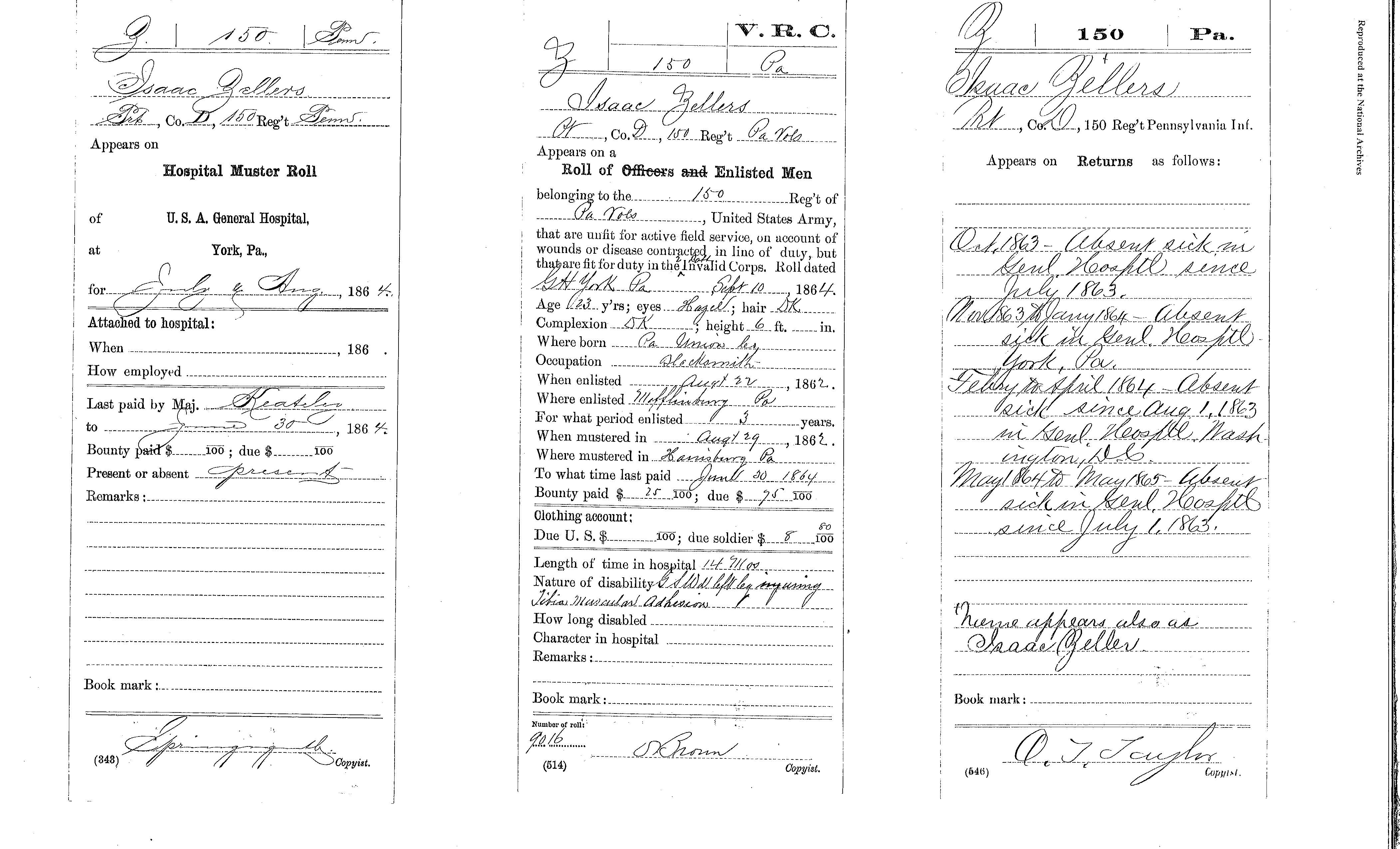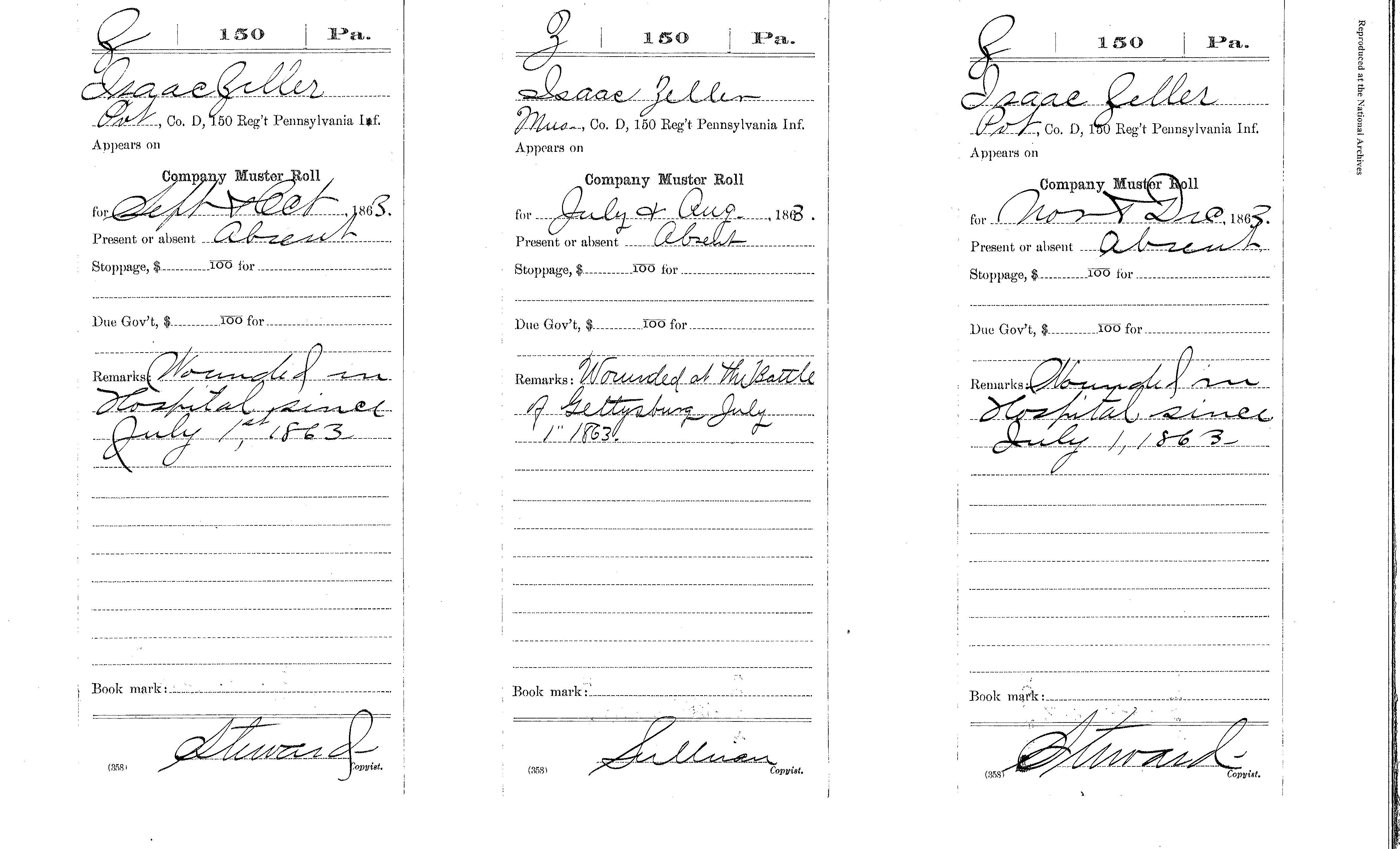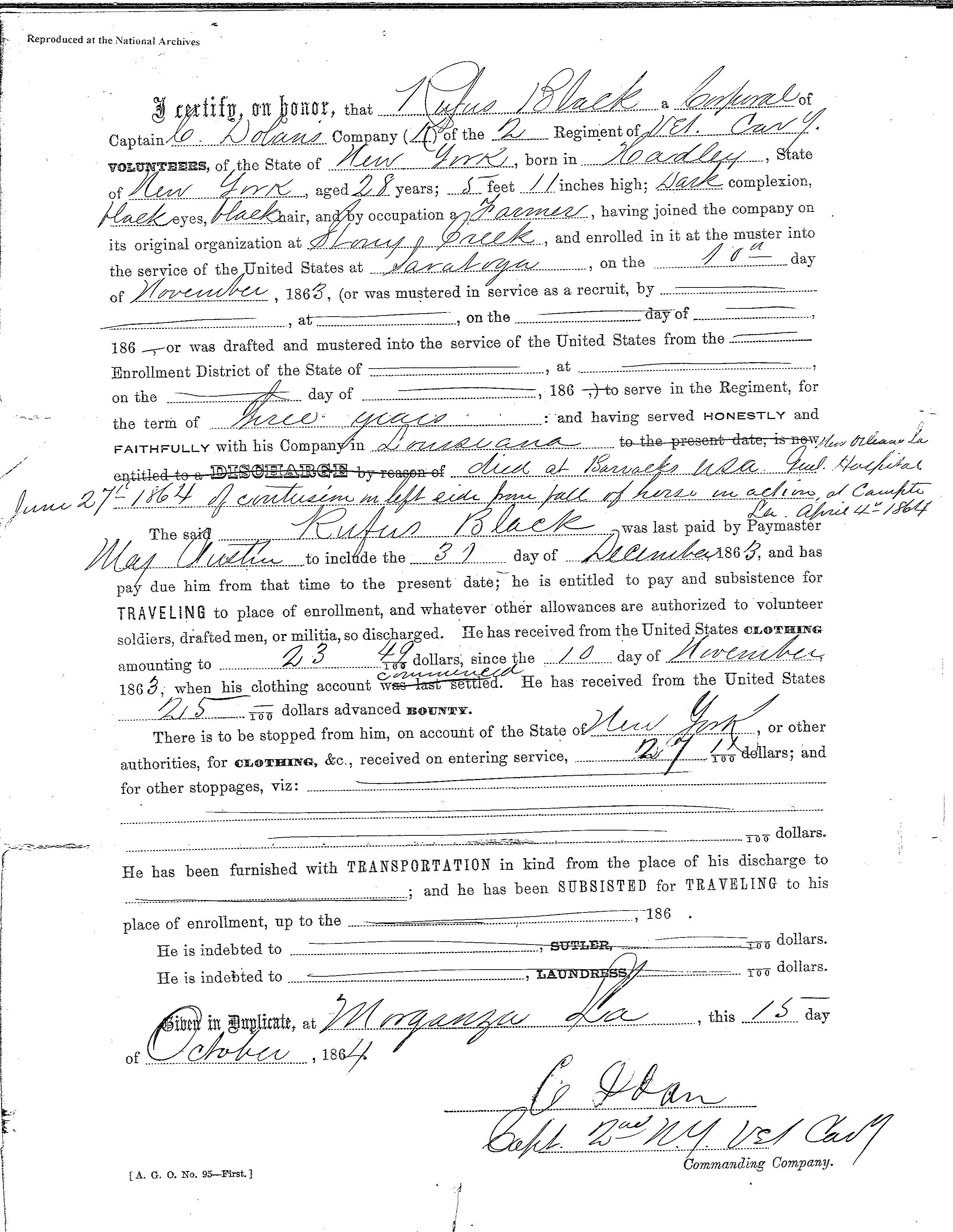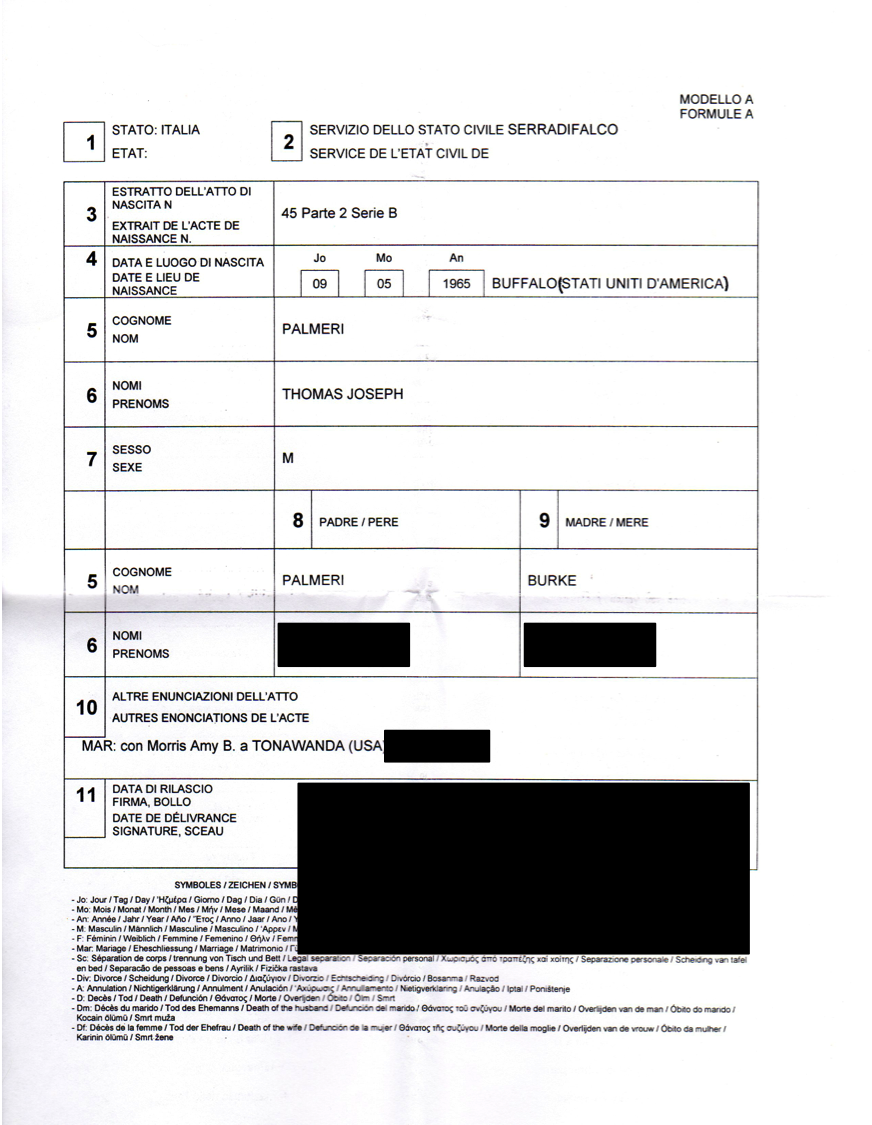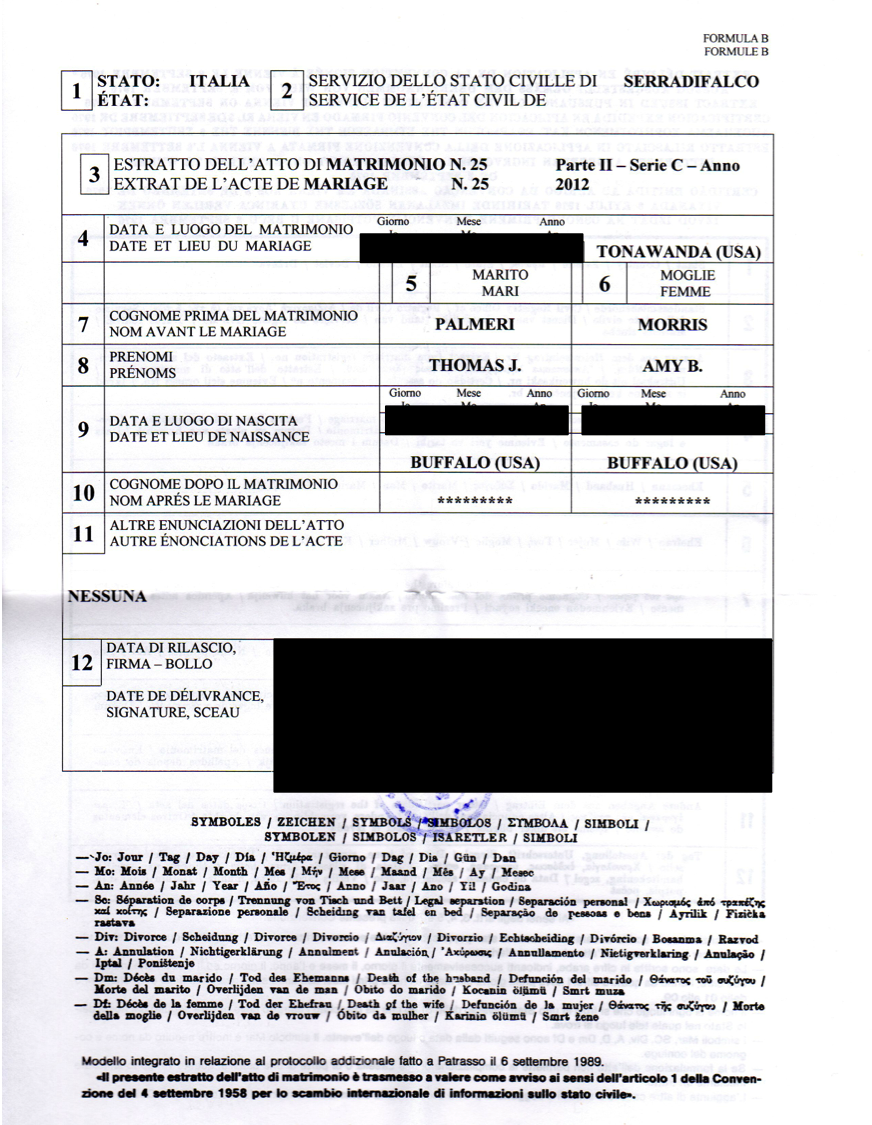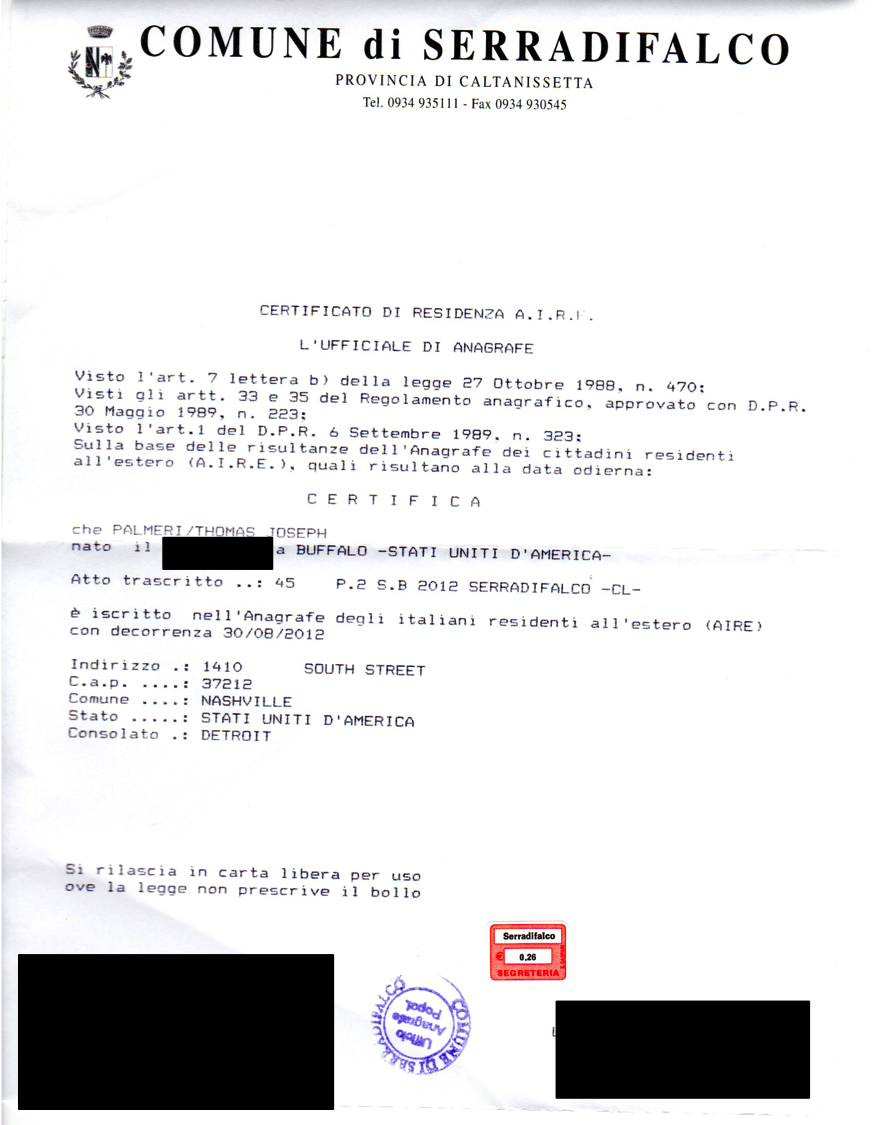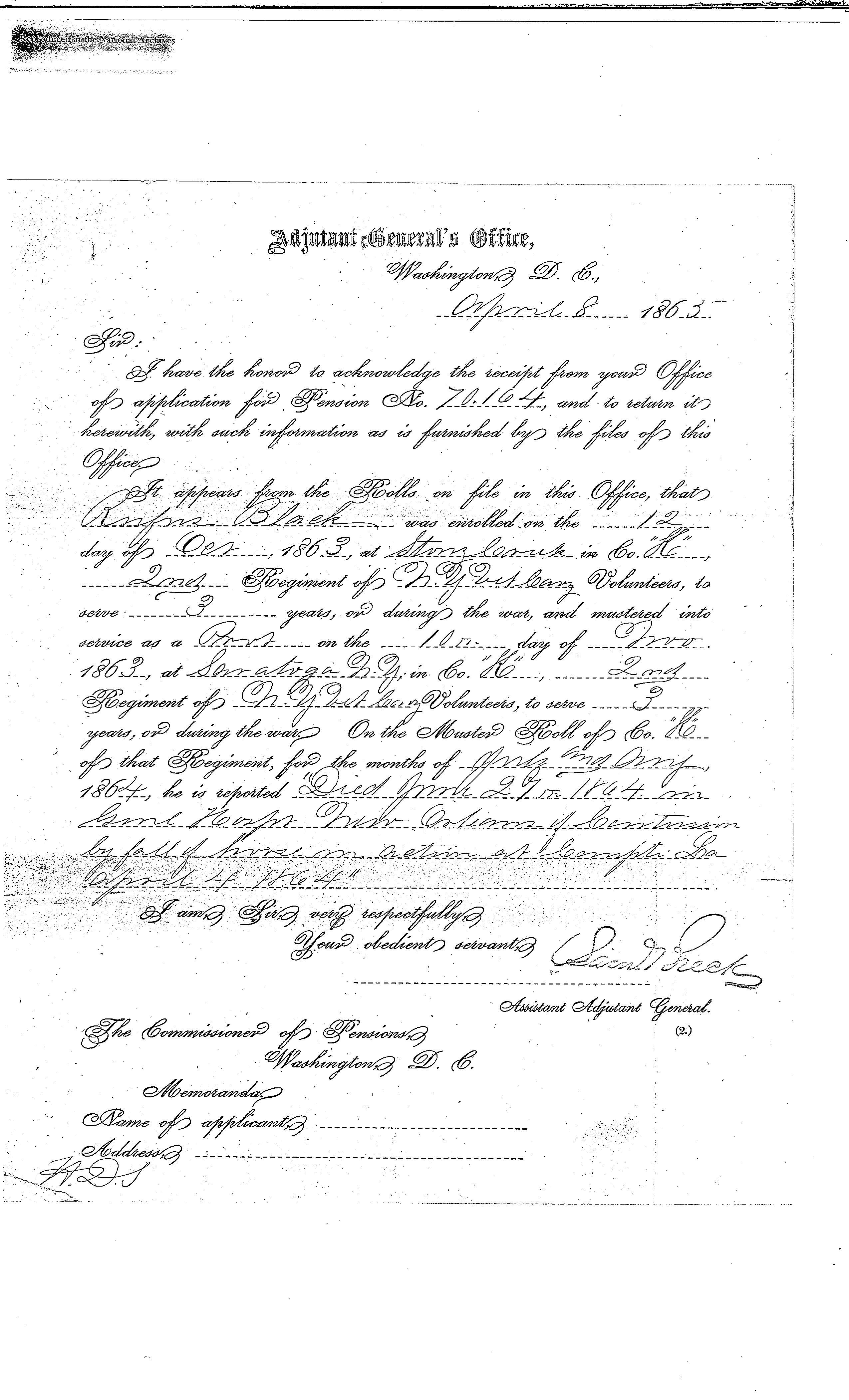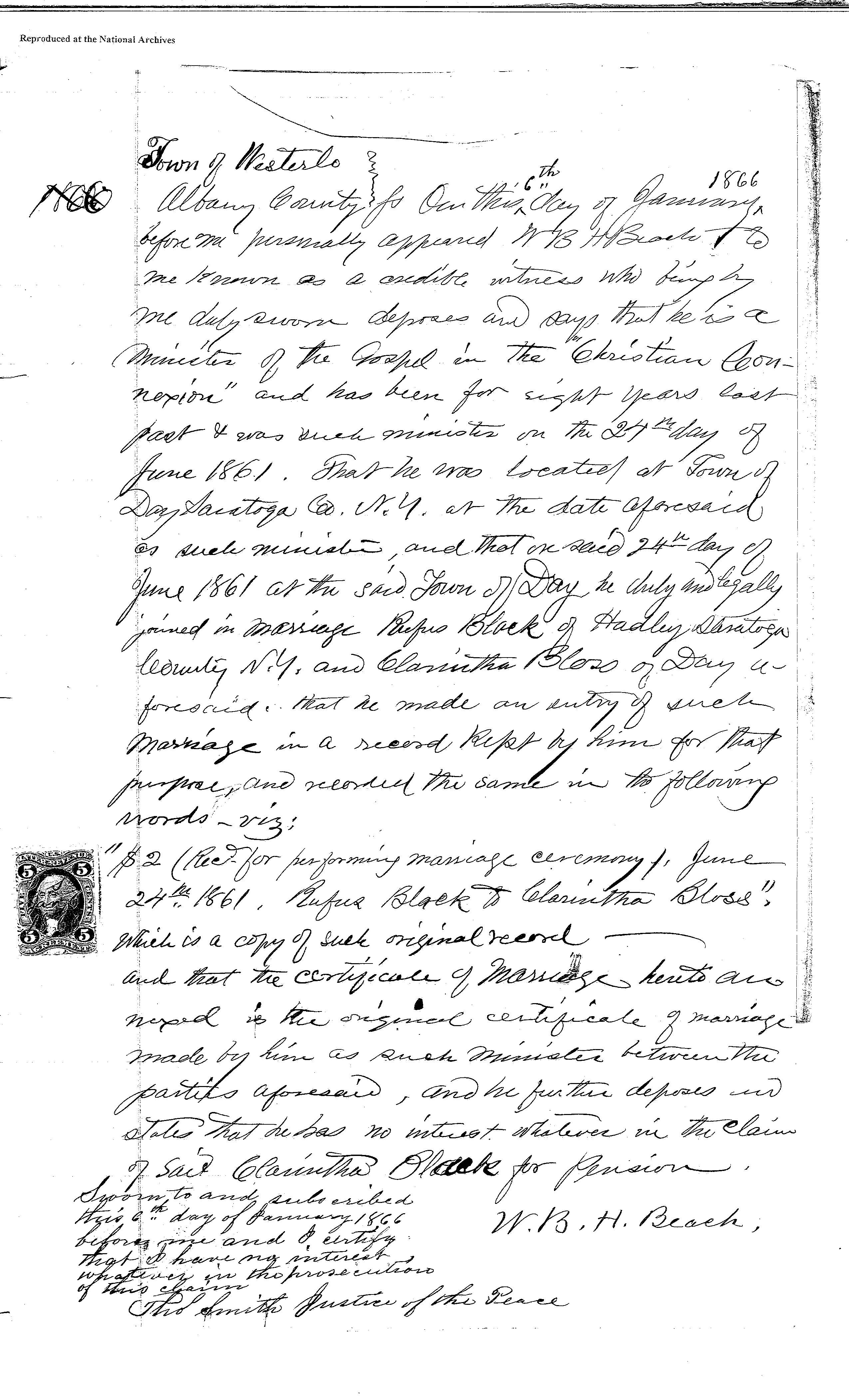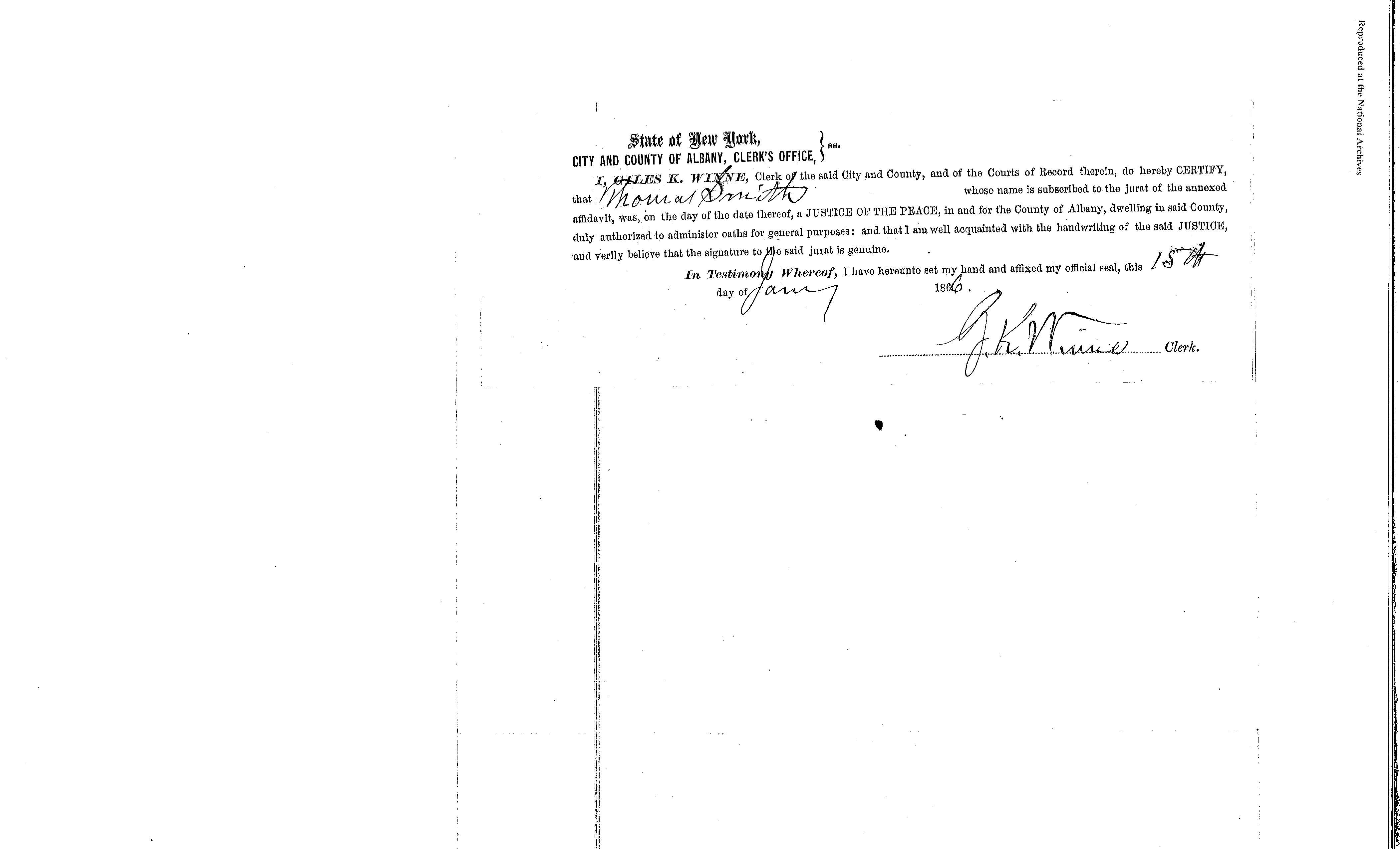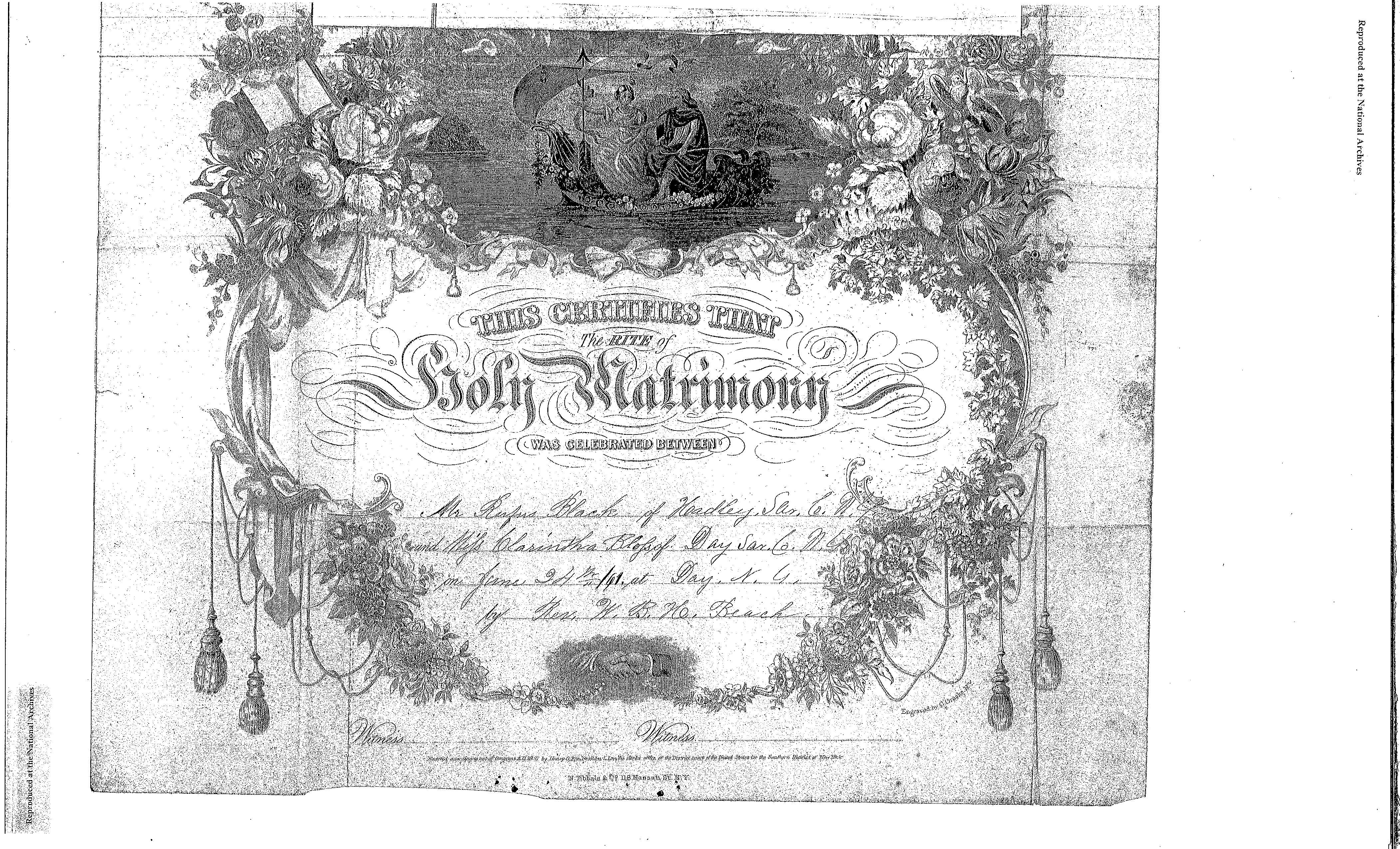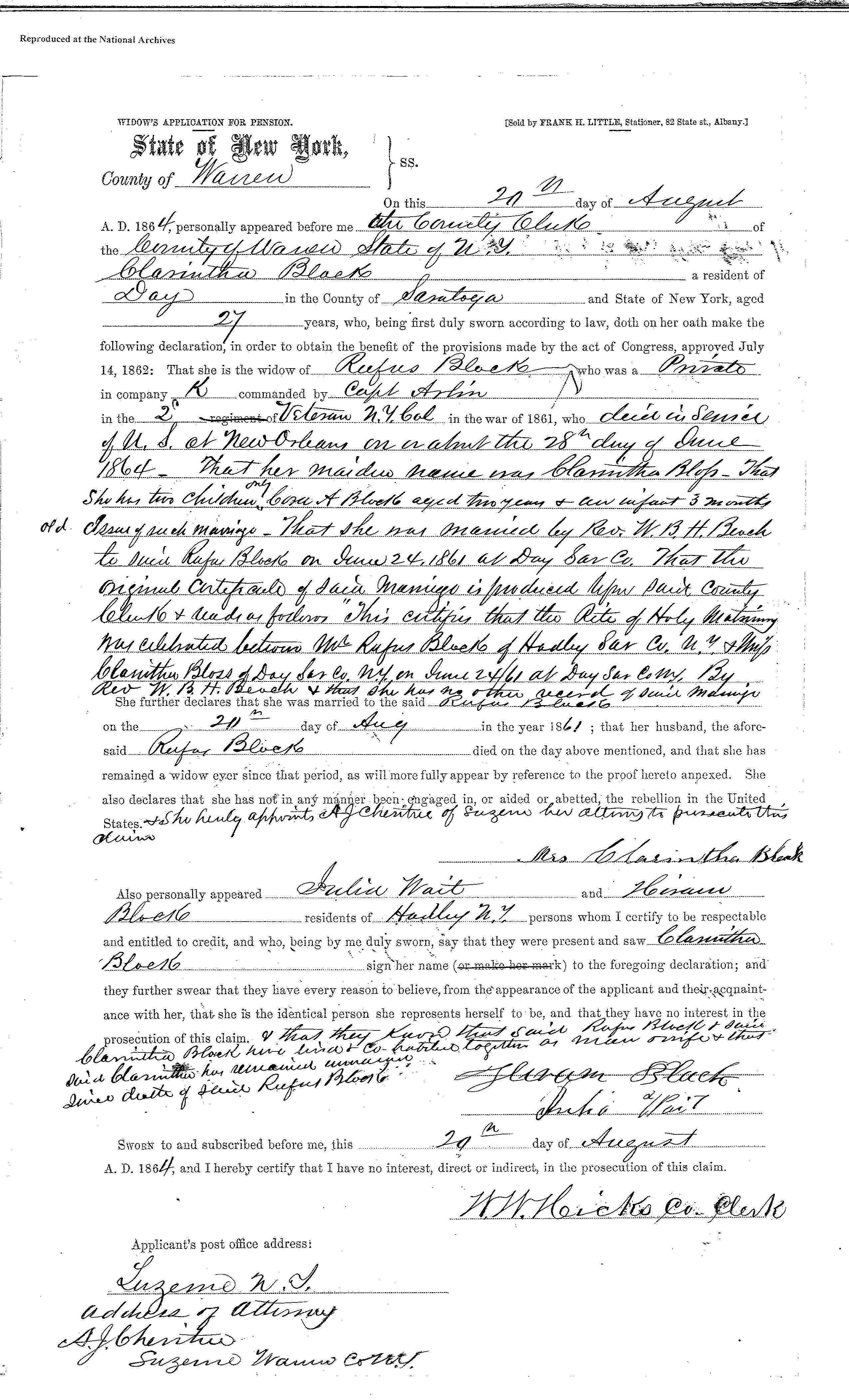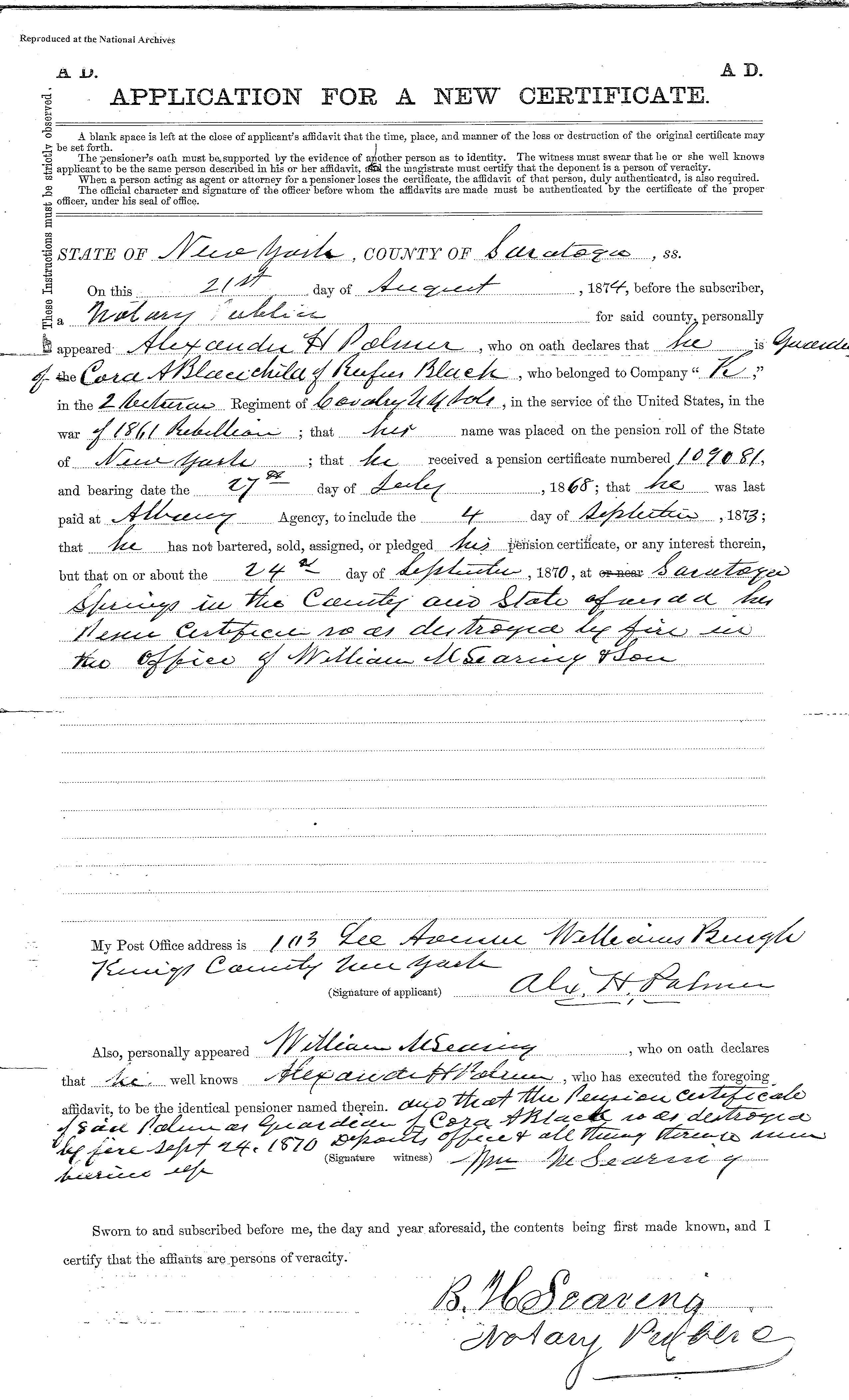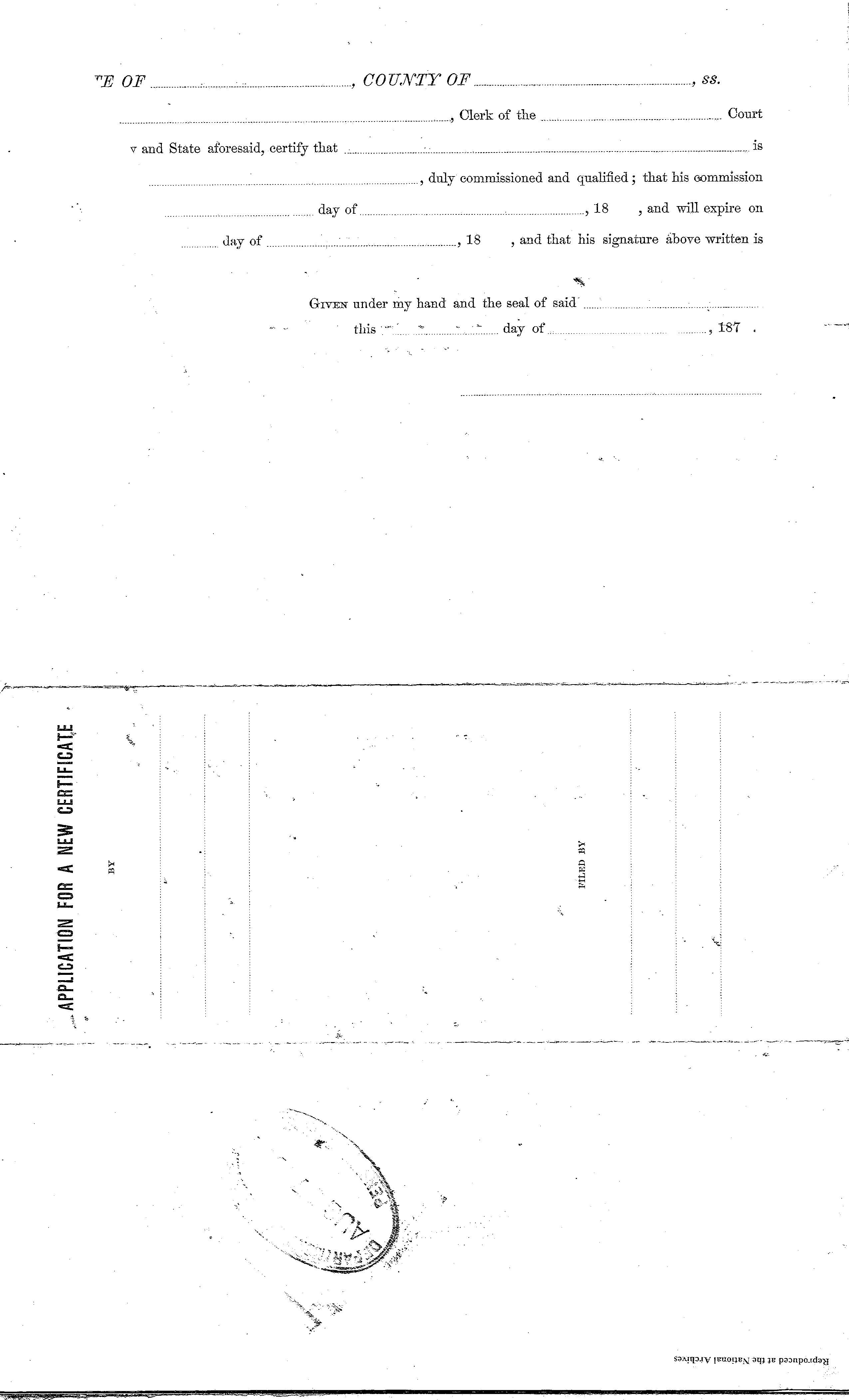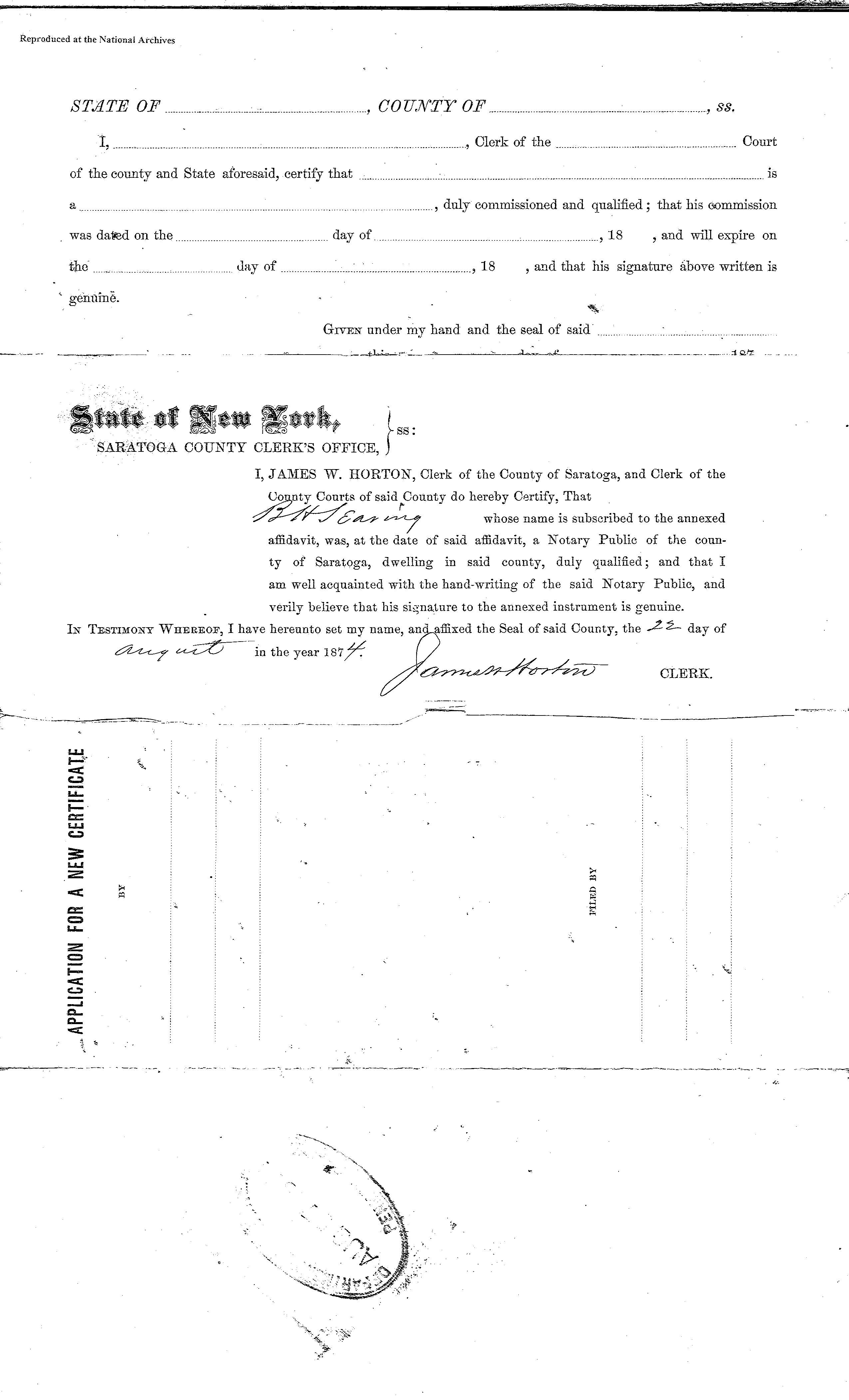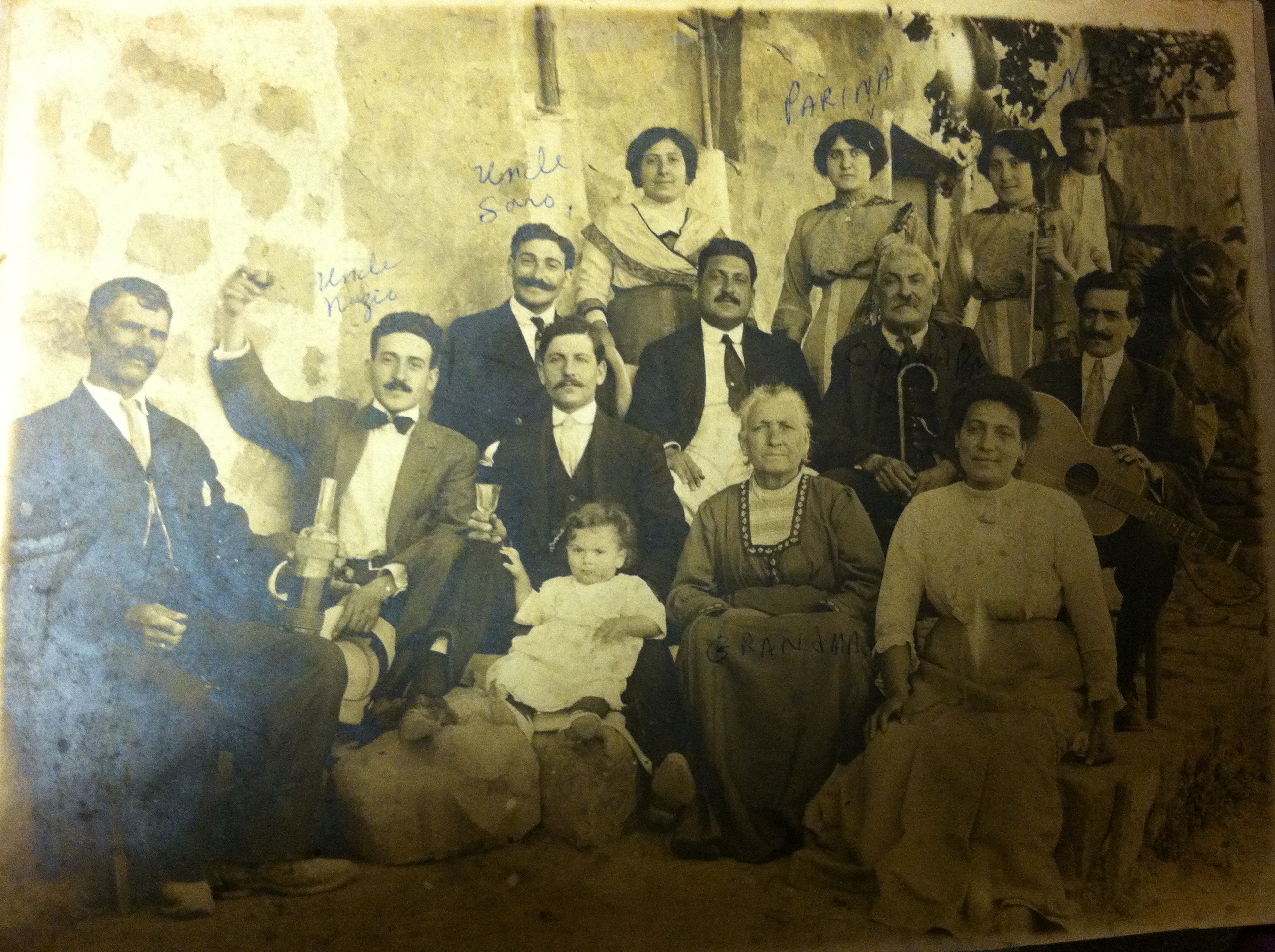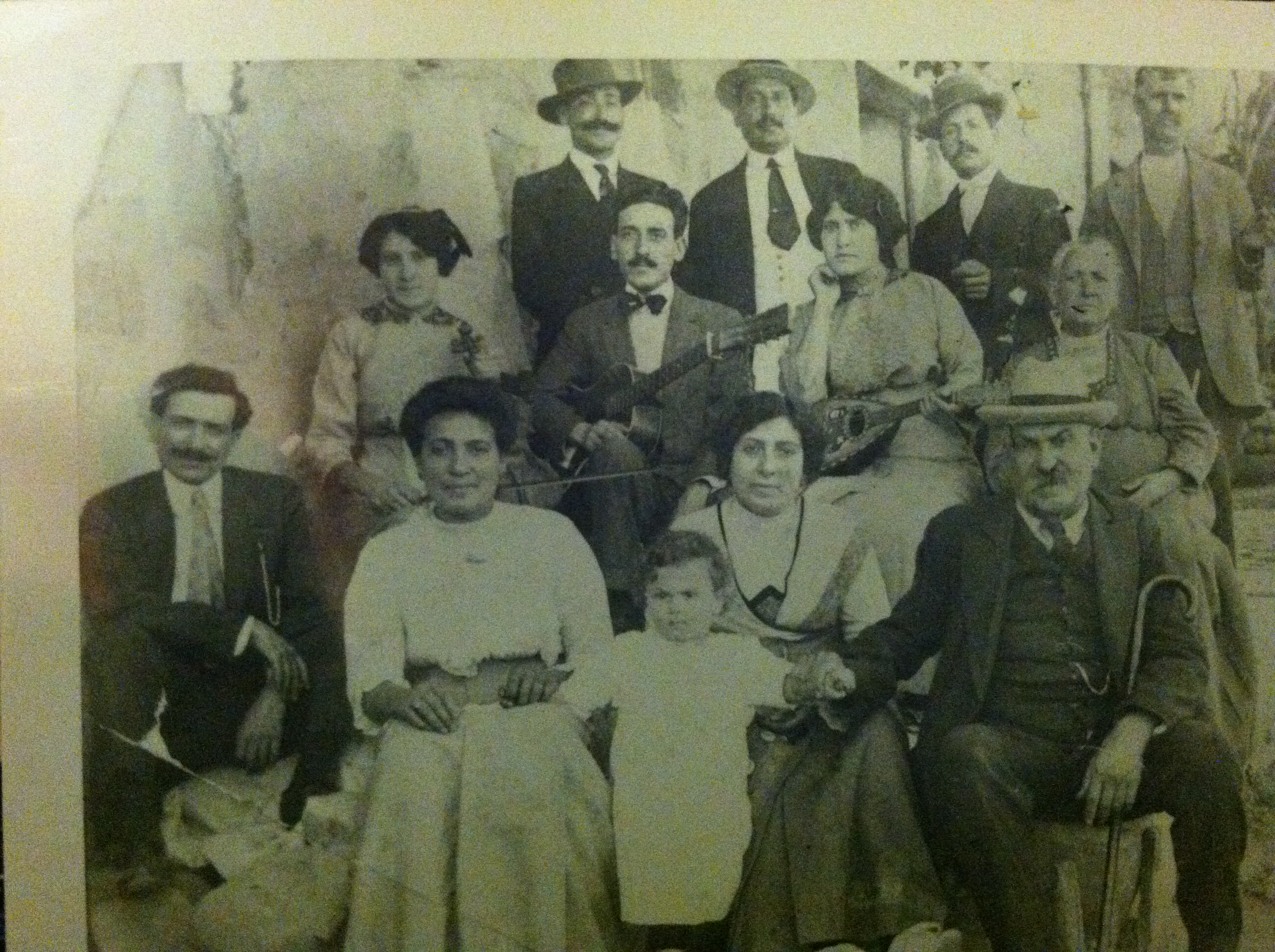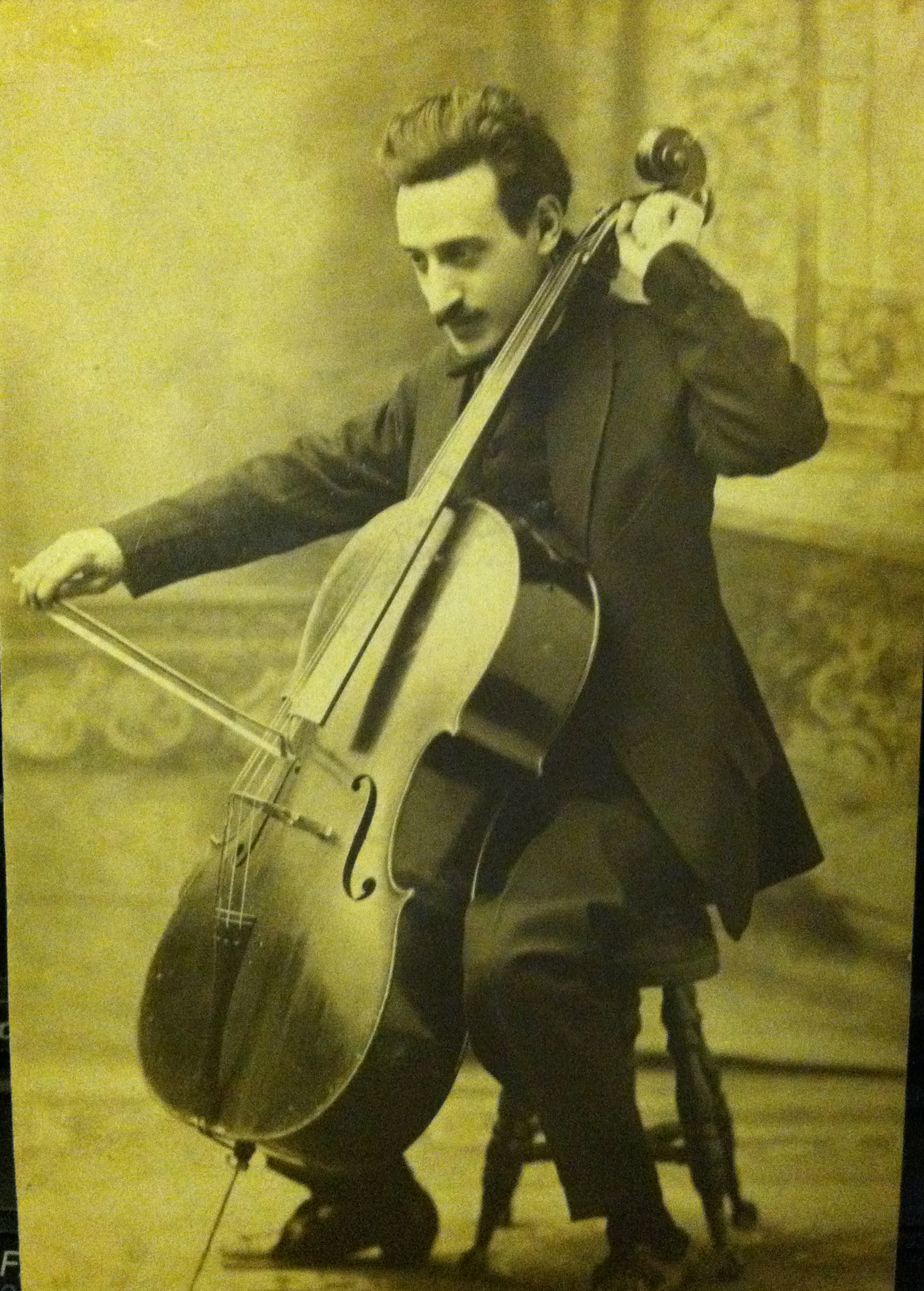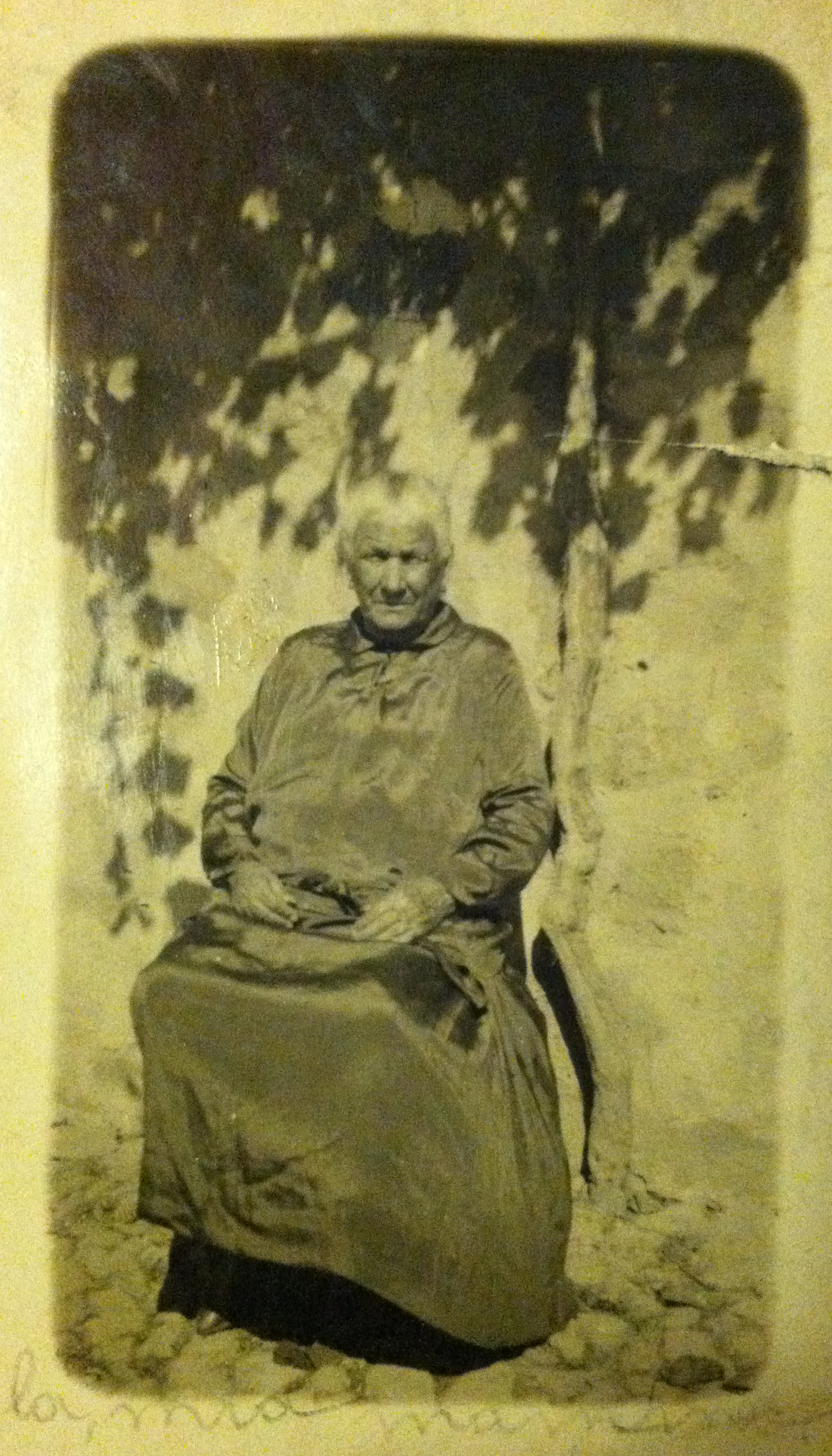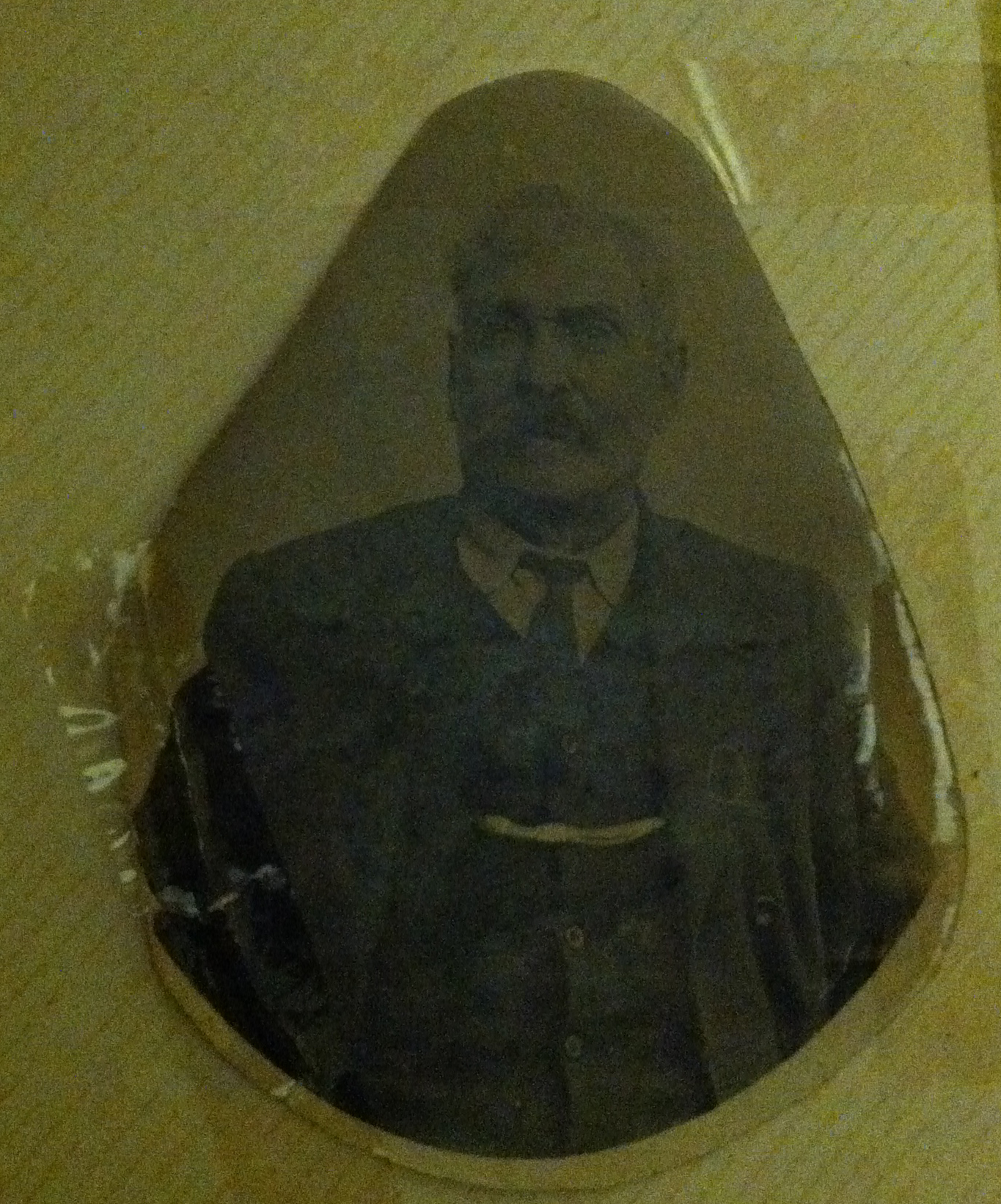Here is a story about the 150th Pennsylvania Volunteers which I got from here: http://www.pa-roots.com/pacw/infantry/150th/150thorg.html
Isaac Zellers, my wife's great-great-great-grandfather, served in the 150th and was injured during the Battle of Gettysburg. He spent the rest of the war in the hospital.
The companies of the 150th were recruited as follows:
Company A – Philadelphia
Company B – Philadelphia
Company C – Crawford County
Company D – Union County
Company E – Philadelphia
Company F – Philadelphia
Company G – M'Kean County
Company H – Crawford County
Company I – Crawford County
Company K – Crawford County
They rendezvoused at Camp Curtin, where, on the 4th of September, a regimental organization was effected with the following field officers:
Launghorne Wister, of Philadelphia, Colonel
Henry S. Huidekoper, of Crawford County, Lieutenant Colonel
Thomas Chamberlin, of Union County, Major
Colonel Wister had served with distinction in the battle of Dranesville, and in the entire Peninsular campaign, in command of a company of the old Bucktails; Lieutenant Colonel Huidekoper had applied himself closely to the study of tactics, and to squad drill, during the year previous, at Harvard University, where he had graduated in June, and Major Chamberlin had served through the Peninsular campaign, as Captain in the Fifth Reserves, a regiment not inferior in soldierly qualities to the Bucktail.
When the Major received his commission, he was lying in hospital at Baltimore, of a severe wound, received at Charles City Cross Roads, but learning that the enemy was invading Maryland, instead of looking for his new command, he sought out his old regiment, and fought with it through the fiery battles of South Mountain and Antietam. It will thus be seen that the field officers were well fitted for their duties.
Soon after its organization at Harrisburg, it proceeded to Washington, and was immediately assigned to duty as guard, in and about the city. Companies D and K being stationed at the Soldiers' Home, the summer residence of the President, where they were drilled by a field officer, and Company A at the Soldiers' Rest, near the Baltimore depot, where, later, it was joined by Company D. Company K continued to act as the President's body guard, until after the assassination of Mr. Lincoln, and until the end of its term of service. A brief sketch of this service will be found at the close of the regimental narration.
During the pleasant weather of the fall, the balance of the regiment was drilled at Meridian Hill. Before mid-winter, nearly all the companies were taken away for guard duty, at various points in and around the city, Lieutenant Colonel Huidekoper, in the meantime, served on a General Court Martial, and Major Chamberlin was detailed on the 23d of October, as commandant of Georgetown, where he remained until his regiment was ordered to the field.
About the middle of February, 1863, the Bucktail troops moved to Belle Plain, where a brigade was formed, consisting of the One Hundred and Forty-ninth, One Hundred and Fiftieth, and One Hundred and Forty-third Pennsylvania regiments, under command of Colonel Stone, which became the Second, of the Third Division, First Corps.
On the 21st of April, the regiment marched with the division to Port Conway, opposite Port Royal, where a feint of crossing was made, returning to camp on the 23d, after a fatiguing march. This expedition was the prelude to the grand campaign about to open, and on the 28th the whole army was in motion, the First Corps moving to Polock's Mills, and on the following day to the bank of the river, where portions of the command were, subjected to a vigorous shelling from the enemy's batteries on the opposite shore, but from which the regiment suffered no loss.
Chancellorsville
On the 2d of May, the corps made a forced march to Chancellorsville, taking position on the extreme right of the line, the brigade holding the left of the corps, joining with the Fifth Corps, the regiment standing, upon the right of the brigade. Pickets were immediately thrown out, advancing cautiously through the thickly wooded ground, uncertain as to the strength and whereabouts of the enemy. Many stragglers from the Eleventh Corps, which had occupied this part of the field on that evening, but from which it had been driven by the impetuous charge of Stonewall Jackson, were picked up, and some prisoners taken.
At daylight, strong breast-works were thrown up, and here the corps remained, without being actively engaged, until the close of the battle. On the 6th, with the rest of the farm, the regiment re-crossed the Rappahannock, and went into camp with the division at White Oak Church, where it remained, with slight changes, until it marched, about the middle of June, on the Pennsylvania campaign.
Gettysburg
At Gettysburg, on the 1st of July, it met the enemy, and really fought its first battle, winning a reputation for valor that will be imperishlable.
"The One Hundred and Fiftieth Regiment," says the report, " came upon the field of battle near Gettysburg, about eleven P.M., July 1st, 1863. We halted in front of the Seminary, to the west of the town, and throwing off our knapsacks, moved forward about half a mile to a position behind the crest of a hill, our right near a large barn, our left joining the Iron Brigade, consisting of Wisconsin and Michigan troops. The ground was gently rolling and open, the only shelter being a slight fence. We had not been long in position before the enemy began to shell us heavily, when, finding that they produced little effect in front, they opened a new battery on our right flank, and began an enfilading fire upon us. Our right flank was exposed, as our brigade held the angle of the two fronts of our army, and the new Whitworth projectiles from this battery killed two and disabled three in company C. We then shifted our position so as to obtain a partial shelter from the barn, before mentioned, the One Hundred and Forty-third, and One Hundred and Forty-ninth, meanwhile, being established in a dug-out road, fronting towards the north, and forming a right angle with the One Hundred and Fiftieth, which fronted westward. The enemy continued to shell our position until about two P. M., without, however, disabling more than ten or twelve men. Company B, Captain Jones, which had been sent forward as skirmishers, was, meanwhile, actively engaged in our front, sustaining considerable loss. About this time, Colonel Stone1, commanding the regiment, having gone forward, to reconnoitre, was hit in the hip and arm by two balls from the enemy's skirmishers and was carried from the field into the barn.
"Colonel Wister then assumed command of the brigade, and Lieutenant Colonel Huidekoper of the regiment. Soon after, a strong force of rebel infantry advanced from the north on our right, and we then changed front forward, so as to come into line with the other regiments of the brigade. This movement was accomplished rapidly, though under a heavy fire. The enemy now approached within less than fifty yards, when they were staggered by our fire, and halted, exchanging shots with us for several minutes. A new line of rebels was seen approaching from the west, against the letf, at a distance of half a mile, and Colonel Wister here ordered a charge, to free us from our old assailants, before the new ones were upon us. This movement was entirely successful. The enemy, who had suffered terriblly from our fire, gave way at once and fled in confusion. The danger of injuring their own troops being now removed, the rebel batteries opened upon us with terrible effect, and the infantry fire from the line advancing upon our left became also very severe. In view of this, Colonel Wister gave orders to change front to the rear, so as to resume our original position. This movement was successfully and rapidly performed, though with a terrible loss."
The colors of the One Hundred and Forty-ninth had been placed at a little distance to draw the enemy's fire, and had been captured by them in the advance spoken of, but were re-captured by a squad of the One Hundred and Fiftieth in this charge. The One Hundred and Forty-ninth then reinforced us in our new line, and we were in position none too soon, as the advancing lines of the rebels were soon upon us. Our men were partially sheltered by a port-and-rail fence, from behind which we poured so severe a fire upon the enemy that their line also gave way. After retreating a short distance, however, they moved off by their right flank, and fixed themselves in a thick wood in front of the Iron Brigade on our left. Colonel Wister was wounded in the face during this encounter, but did not leave the field. No charge was made from this time, a quarter before three, for a considerable interval, but a very heavy artillery and infantry fire was kept up upon us.
During this time, Lieutenant Colonel Hiuidekoper was severely wounded in the right arm, which has since been amputated, and was compelled to leave the field. Adjutant R. L. Ashhurst was wounded in the shoulder, Lieutenant Gilbert B. Perkins in the thigh, and Lieutenant Chancellor, Jr., had his leg almost torn off by a solid shot.
Not long after three P. M., our whole line began to give way. Our brigade, however, had no orders to retreat, and continued to hold its ground for some time, when, finding ourselves almost surrounded by the enemy, we at last fell back, slowly, under a very severe fire. The Iron Brigade had fallen back some time before ours, and had formed a new line on the crest of the next ridge, midway between the Seminary and the front. Here we again halted, and withstood the enemy's attacks for some time; but the line giving way on all sides, and finding ourselves again becoming surrounded, we were compelled again to fall back.
On our retreat, we found one of our batteries on which the enemy was directing a heavy fire, and which they were preparing to assault. Here the remainder of our men again rallied in an orchard, and succeeded in repelling a desperate rebel charge on the battery. We held this position, though the rest of the line had given way, until the guns of the battery were limbered up, horses hitched, and the commanding officers said they were ready to move to a place of safety. An aid rode up soon after, with orders for us to retreat through the town to the new line formed on the south side. This we proceeded to do; but our retreat had been so long delayed, that many of our men were captured in the streets of Gettysburg, the enemy having closed in both on our right and left.
"" Up to this time," says Major Chamberlin, " our colors were safe. The Color Sergeant had been killed in the orchard, and all the color guard had been killed or wounded, except one, some of them receiving three or four balls. The colors were held by Corporal Gutelius, of company D, who carried them to the town, and insisted on keeping them, although he was slightly wounded. Stopping a moment to rest, the rebels were on him, and he was shot dead with the colors clasped in his arms. This is the same flag which was presented to Jefferson Davis, with a flourish of trumpets, at the request of a North Carolina Lieutenant, who, it was alleged, with a handful of sharp-shooters, scattered a Pennsylvania regiment, and captured their colors; but in doing so, was himself mortally wounded. The flag was found with Jefferson Davis' effects, when he was overhauled in Georgia, in the spring of 1865. "This flag was held by the Secretary of War, until October 25th, 1869, when it was transmitted to the Adjutant General of this State, with a letter, in which he says " I am directed by the President to send herewith, the flag of the One Hundred and Fiftieth Pennsylvania Volunteers, said to have been captured at Gettysburg, and re-captured in the baggage of Jeff. Davis."
It is now deposited with the other tattered ensigns of the State, in the Capitol at Harrisburg."
Upon arriving at the Cemetery, it was re-formed, and rested in line during the night. On the following day it was held in reserve, in rear of Cemetery Hill, and at night, was sent with the One Hundred and Forty-ninth to rescue some pieces of artillery of a regular battery, which had been lost. Two guns and four caissons were secured, and brought off, the regiment remaining on the field during the night, and retiring in the morning with only small loss. It was under a severe fire of artillery in the afternoon, and was held in readiness to charge, when the enemy made his last attack a little to the left of the position which it held; but before the order to advance was given, he had been most disastrously repulsed, and the battle was at an end.
The regiment went into the battle with seventeen officers, and about four hundred men. Of these, forty-three were killed, one hundred and thirty-eight wounded, and sixty-nine taken prisoners. Lieutenants E. B. Weidensau, Charles P. Keyser: and Henry Chancellor, Jr., were of the killed; Colonel Wister, Lieutenant Colonel Huidekoper, Major Chamberlin, Adjutant Richard L. Ashhurst, Captains William P. Dougal, John W. Sigler, and Lieutenants Gilbert B. Perkins, C. W. Sears, and Miles F. Rose, of the wounded, and Captain Cornelius C. Widdis, Henry W. Gimber, and Lieutenants John Q. Carpenter, and Joseph Chatburn, were of those taken prisoners. But two officers remained, and one of these was wounded. The companies uniformly lost heavily.
Two incidents connected with this regiment, at the opening, of the battle, which are related by Major Chamberlin, are worthy of commemoration.
" Soon after taking up our line in the orchard," says he,'" an old gentleman approached us from the direction of the town, dressed in a blue, swallow-tailed coat, and high silk hat, rather worse for the wear, carrying a musket, and asked me if he could be allowed to fight with our regiment. I answered that there could hardly be any objection, but referred him to Colonel Wister, who stood near. On repeating his question to the Colonel, Wister asked him if he could shoot.'Oh, yes,' said the old gentleman.'But where are your cartridges,' asked the Colonel' Slapping his hand on his pantaloons pocket, he replied,' I have them here.''Certainly you can fight with us,' said the Colonel,' and I wish there were many more like you.' The Colonel, however, told him that he had better go into the wood to our left, as he could do more damage there, and be less liable to be hit. The old man went into the wood, and joined one of the regiments of the Iron Brigade, and history will preserve the memory of old John Burns, as long as it tells the story of the great battle of Gettysburg." It may be added, that he fought heroically, and was wounded in the side and leg, and left insensible upon the field. He was finally rescued, and taken to his home. He survived his injuries, and is now a hale old man, on the verge of eighty."'
Dennis Buckley, company H, Sixth Michigan Cavalry,:" continues Major Chamberlin, "whose horse had been shot under him in the cavalry encounter that morning, joined our regiment with his carbine, and asked permission to fight with us. Soon after, a shell from a rebel battery exploded in the midst of Company C, killing two men instantly, and dangerously wounding three others, when Buckley joined that company, saying,' that is the company for me.' He remained with the regiment during the whole of the enagagement of the first day, doing good service with his carbine, and escapring unharmed."
After the battle, the regiment joined with the army in following up the re-treating enemy, to the neighborhood of Williamsport, where, failing to intercept him, or to bring on another general engagement before his escape across the river, the two armies returned to the Rappahannock. At this time, the regiment was reduced to less than two hundred men, and was deficient in arms, accoutrements, and clothing. Captain Jones, and Lieutenant Kilgore,were sent to Philadelphia, on recruiting service, and during the fall it received considerable accessions of strength.
On the 16th of September it crossed the Rappahannock, and advanced with the army to the Rapidan, but soon after retired to Centreville, the rebel force boldly taking the iuitiative, and moving upon the right flank of the Union army. Frustrated in his purposes, Lee began again to retire, and Meade to follow.
On the 1st of November, the brigade was posted at Warrenton Junction, and until the return of the army from Mine Run, it was, employed in guarding the Orange and Alexandria Railroad, after which it went into quarters near Paoli Mills, and subsequently at the town of Culpepper.
Upon the resignation of Colonel Wister, in February, 1864, Lieutenant Colonel Huidekoper was promoted to succeed him, but, being disabled by the loss of his arm, and the wound being still open, he was obliiged to resign. Soon after, for similar reasons, Major Chamberlin also resigned, whereupon, Captain Cornelius A. Widdis was promoted to Lieutenant Colonel, and Captain George W. Jones to Major.
.jpg)
